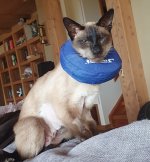SandraNZ
Neuer Benutzer
- Mitglied seit
- 27. Januar 2022
- Beiträge
- 18
Hallo Zusammen,
leider haben mich die Sorgen um Scratty, unsere Siamkatze, hergefuehrt...

Scratty ist app. 10 Jahre alt- wir haben sie vor ca. 4 Jahren "geerbt", weil ihr alter Besitzer, ein Hobby Zuechter, verstorben ist, und seine Witwe wollte die Siamkatzen nur loswerden- ein Maul mehr oder weniger zu fuettern machte uns nichts aus, daher nahmen wir sie gerne auf! Madame war gleich die Queen- in ihrem alten Leben hatte sie wohl etliche Shows in NZ und Australien gewonnen- bei uns wurde sie gleich umbenannt- "Scratty' passte viel besser als "Kiara" . Und was eine Diva sie ist! Aber eine ganz Suesse...
Nun ja- Scratty wurde von uns geimpft, und nach ca. 1 Jahr der erste Schock- Notfall zum Tierarzt, sie war ganz gelb- es wurden keine roten Bluetkoerperchen mehr produziert.! Es war touch and go, doch gluecklicherweise hat sich ihr Zustand wieder gebesser- sie war eine Woche in der Tierklinik im Sauerstoffzelt, ihr Koerper fing wieder an, rote Blutkoerperchen zu produzieren und sie war schliesslich wieder die Alte! 3- monatliche Blutkoerperchen- Zaehlungen waren immer im gruenen Bereich.
Dann, vor ca. 1 Jahr- ein Knoten an der Zitze. Ab zum Tierarzt, Knoten wurde entfernt- zum Glueck war er gutartig!
Dann, kurz vor Weihnachten, entdeckten wir wieder 2 kleine Knoten- wieder neben einer Zitze. Diese wurden vor 2 Wochen entfernt- diesmal jedoch schlechte Nachrichten: boesartig! Die Aerztin schnitt alles raus was sie konnte, der Laborbefund war dann ernuechternd: zwar wurden die beiden Tumore komplett erwischt mit keinen weiteren Befunden am Rand der Masse, doch anscheinend wurden Krebszellen in der Lymphfluessigkeit festgestellt...
Heute nun war Scratty wieder beim TA, Faeden ziehen und Roentgenbilder machen von der Lunge- zum GLueck scheint diese nicht befallen zu sein! Die entgueltige Antwort bekomme ich erst in 2 Tagen, da noch ein weiterer Exporte ueber die Bilder schauen will, aber soweit konnte nichts auffaelliges gesehen werden.
Jetzt koennen wir nur hoffen, dass der Experte nichts in der Lunge findet und der Krebs doch noch nicht gestreut ist... Scratty ist fit und munter, zeigt keinerlei Anzeichen irgendeiner Krankheit.
Alle Daumen und Zehen werden nun gebraucht...
leider haben mich die Sorgen um Scratty, unsere Siamkatze, hergefuehrt...
Scratty ist app. 10 Jahre alt- wir haben sie vor ca. 4 Jahren "geerbt", weil ihr alter Besitzer, ein Hobby Zuechter, verstorben ist, und seine Witwe wollte die Siamkatzen nur loswerden- ein Maul mehr oder weniger zu fuettern machte uns nichts aus, daher nahmen wir sie gerne auf! Madame war gleich die Queen- in ihrem alten Leben hatte sie wohl etliche Shows in NZ und Australien gewonnen- bei uns wurde sie gleich umbenannt- "Scratty' passte viel besser als "Kiara" . Und was eine Diva sie ist! Aber eine ganz Suesse...
Nun ja- Scratty wurde von uns geimpft, und nach ca. 1 Jahr der erste Schock- Notfall zum Tierarzt, sie war ganz gelb- es wurden keine roten Bluetkoerperchen mehr produziert.! Es war touch and go, doch gluecklicherweise hat sich ihr Zustand wieder gebesser- sie war eine Woche in der Tierklinik im Sauerstoffzelt, ihr Koerper fing wieder an, rote Blutkoerperchen zu produzieren und sie war schliesslich wieder die Alte! 3- monatliche Blutkoerperchen- Zaehlungen waren immer im gruenen Bereich.
Dann, vor ca. 1 Jahr- ein Knoten an der Zitze. Ab zum Tierarzt, Knoten wurde entfernt- zum Glueck war er gutartig!
Dann, kurz vor Weihnachten, entdeckten wir wieder 2 kleine Knoten- wieder neben einer Zitze. Diese wurden vor 2 Wochen entfernt- diesmal jedoch schlechte Nachrichten: boesartig! Die Aerztin schnitt alles raus was sie konnte, der Laborbefund war dann ernuechternd: zwar wurden die beiden Tumore komplett erwischt mit keinen weiteren Befunden am Rand der Masse, doch anscheinend wurden Krebszellen in der Lymphfluessigkeit festgestellt...
Heute nun war Scratty wieder beim TA, Faeden ziehen und Roentgenbilder machen von der Lunge- zum GLueck scheint diese nicht befallen zu sein! Die entgueltige Antwort bekomme ich erst in 2 Tagen, da noch ein weiterer Exporte ueber die Bilder schauen will, aber soweit konnte nichts auffaelliges gesehen werden.
Jetzt koennen wir nur hoffen, dass der Experte nichts in der Lunge findet und der Krebs doch noch nicht gestreut ist... Scratty ist fit und munter, zeigt keinerlei Anzeichen irgendeiner Krankheit.
Alle Daumen und Zehen werden nun gebraucht...



